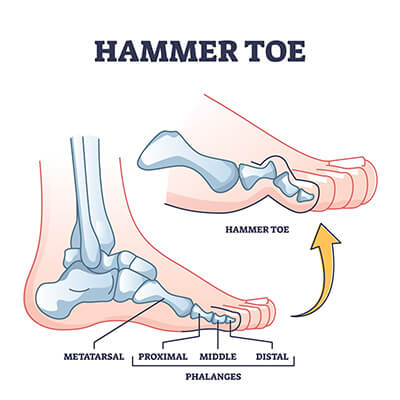 Hammertoes are a common foot deformity that can cause significant pain and discomfort. This condition typically affects the second, third, or fourth toes, causing them to bend at the middle joint, giving them a hammer-like appearance.
Hammertoes are a common foot deformity that can cause significant pain and discomfort. This condition typically affects the second, third, or fourth toes, causing them to bend at the middle joint, giving them a hammer-like appearance.
Understanding the causes of hammertoes is essential for both prevention and effective treatment. Let’s look at the factors that contribute to hammertoes’ development and tips on keeping your feet healthy.
The Anatomy of the Foot and Its Role in Hammertoes
The foot is a complex structure composed of bones, joints, muscles, tendons, and ligaments. It is divided into three main parts: the hind-foot (which includes the heel and ankle bones), the mid-foot (which forms the arches and the ball of the foot), and the forefoot (which includes the toes).
The delicate balance of muscles, tendons, and bones in the foot is crucial for maintaining proper toe alignment. When this balance is disrupted – whether by external factors like footwear or internal factors like muscle weakness – it can lead to hammertoes.
The Three Main Causes
1. Footwear
One of the leading causes of hammertoes is improper footwear. Shoes that are too tight, too loose, or have a narrow toe box can squeeze the toes into a cramped position, leading to deformities over time. High heels and shoes with pointed toes are particularly problematic, as they force the toes into unnatural positions, increasing the risk of this foot deformity.
2. Muscle Weakness and Imbalance
The muscles in the feet must work together to maintain proper toe alignment. When there is a muscular imbalance between the toe flexors and extensors, the toes can become misaligned, leading to hammertoes. This imbalance often occurs due to prolonged periods of wearing restrictive footwear, lack of foot exercises, or ageing.
3. Medical Conditions
Several medical conditions can also contribute to the development of hammertoes. Arthritis, for example, can cause inflammation and deformities in the joints, including those in the toes. Diabetes, which can lead to nerve damage and reduced sensation in the feet, increases the risk of hammertoes. Additionally, neuromuscular disorders like cerebral palsy and muscular dystrophy can affect muscle function, further contributing to this condition.
Natural Ways to Address Hammertoes
Chiropractic Care
Chiropractic care may be beneficial for managing hammertoes by addressing misalignments in the feet and lower body that may contribute to the condition. Specific adjustments can help improve toe alignment, reduce pain, and enhance overall foot function. Regular visits to a chiropractor may prevent the progression of this deformity and other related issues.
Selecting Proper Footwear
Choosing the right footwear is crucial in preventing and managing hammertoes. Opt for shoes with a wide toe box to give your toes ample space to move. Avoid high heels and shoes with pointed toes, as they can exacerbate the problem. Instead, look for shoes with good arch support and cushioning to minimise pressure on the toes.
Foot Exercises
Strengthening the muscles in your feet can help correct imbalances and improve toe alignment. Exercises such as toe curls, picking up small objects with your toes, and stretching the toes can enhance muscle tone and flexibility, reducing the risk of hammertoes.
Orthotic Devices
Custom orthotic devices can provide additional support and help correct abnormal foot mechanics. These inserts are designed to fit inside your shoes and can alleviate pressure on the toes, promoting better alignment and reducing discomfort.
Frequently Asked Questions
Can hammertoes be prevented? What are the symptoms of hammertoes? Do hammertoes cause any complications?Book an Appointment
If you’re already experiencing symptoms, early intervention is key to managing the condition and preventing further complications. Chiropractic care may help alleviate symptoms, improve toe alignment, and restore foot function. Schedule an appointment with Harvey Young today.
Disclaimer: Our educational content is not meant to replace your medical treatment. Always seek professional advice for your health-related issues.
